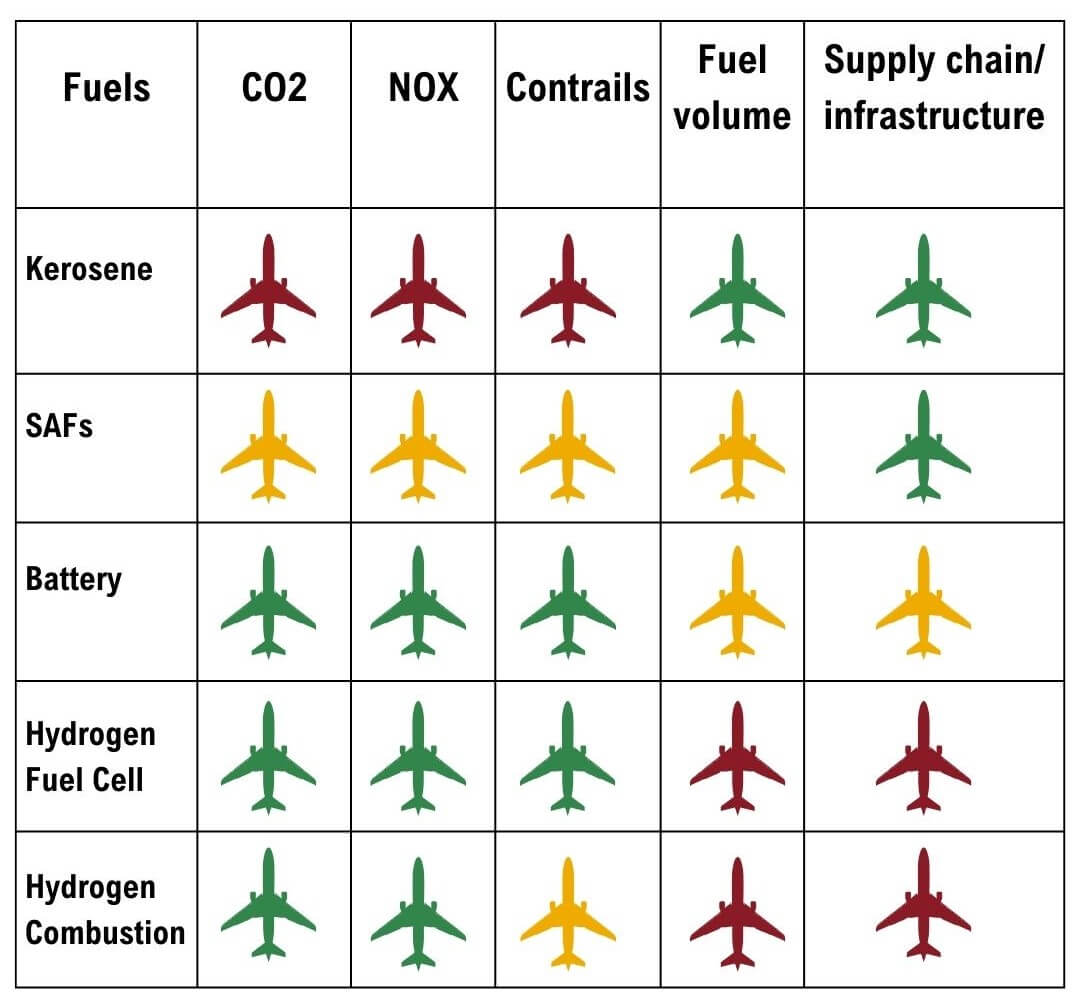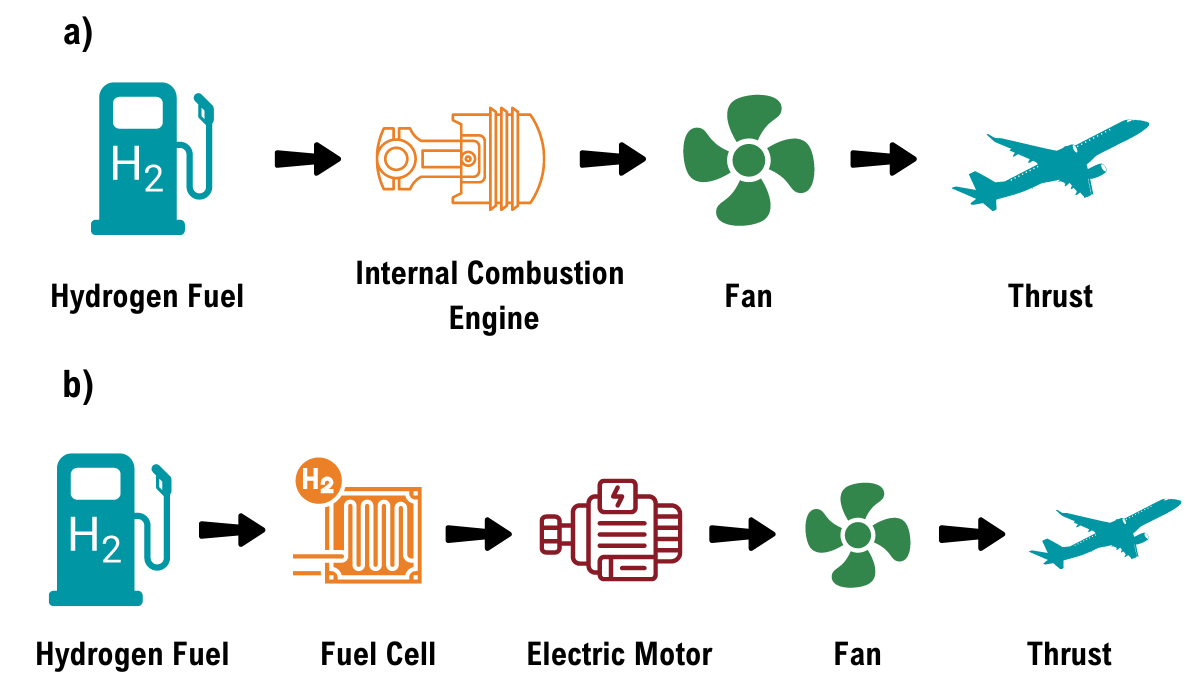
Decarbonizing the Aviation Sector: The Role of Hydrogen
The 2023 United Nations Climate Change Conference (COP28) that concluded earlier this week saw delegates from across the world fly down to Dubai, leading to resurfacing of the dilemma of carbon emissions associated with flying to attend the climate conference. The aviation industry accounted for 2.4% of the global carbon dioxide (CO2) emissions in 2022, and decarbonizing this hard-to-abate sector is a challenge, especially given that air travel could more than double by 2050.
It is evidently critical for the aviation industry to find ways to mitigate emissions. Migrating to newer technologies, like sustainable aviation fuels (SAF), battery electric or green hydrogen has the potential to reduce CO2 emissions. However, these underlying technologies are still in their infancy compared to commercially available aviation fuel. This blog analyzes the potential of these alternative fuels and delves into the challenges associated with the adoption of hydrogen for commercial aviation.
Biofuel, Electric or Hydrogen?
Rapid adaptation of new fuel technologies is required for the transition towards greener alternatives. For decades now, fossil-based kerosene has been used in the aviation industry and the existing infrastructure is suited for this fuel. The high density of kerosene makes it favorable for larger payloads and longer flights, but it emits large amounts of greenhouse gases (GHG) like carbon dioxide (CO2) and nitrogen oxides (NOx.). In comparison, SAFs are made of non-petroleum feedstock, encompassing renewable or waste-derived aviation fuels with similar properties to conventional jet fuel but with a lower carbon footprint. However, SAFs also have lower energy densities so larger volumes of fuel are required for the same payload and range. While their limited availability and production make them expensive, SAFs have the advantage of being easy to incorporate into the existing infrastructure with minimal modifications.
Battery electric propulsion also offers promising avenues to enhance operational energy efficiency, minimize environmental pollution, and reduce noise emissions. However, the limitations in electrical energy storage performance and the weight of the battery limit the applications of electrical propulsion systems to smaller aircrafts and short-haul flights. For long-haul flights, the primary approach involves either battery swaps or regular charging. This is because excessive battery overheating can lead to thermal runaway, posing the risk of accident.
The introduction of a new aircraft, solely powered by clean hydrogen, could contribute to making air transport completely carbon free. Hydrogen has thrice the gravimetric energy density of kerosene and offers the potential to fuel larger planes. With several benefits over SAF and batteries, Hydrogen is a strong contender for a suitable alternative fuel.

- The Growth in Greenhouse Gas Emissions from Commercial Aviation (2019, revised 2022), EESI.
- Hydrogen and its potential in aviation, EASA.
- What is sustainable aviation fuel (SAF)?, BP.
- Hydrogen-powered aviation: A fact-based study of hydrogen technology, economics, and climate impact by 2050, EURACTIV.
Hydrogen-Powered Aviation
Currently, two methods of hydrogen propulsion are being explored: combustion and fuel cell, see Figure 2. In the case of hydrogen combustion aircraft, the thrust is generated through the combustion of hydrogen in a modified jet engine and it shows an approximate efficiency of 40%. Whereas, in hydrogen fuel cell-powered aircraft, electricity produced from hydrogen and oxygen powers an electric motor that drives the propeller, and the resulting efficiency is 45% to 50%. Both technologies are under active consideration and many countries and companies are funding multi-million-dollar projects to develop hydrogen-fueled aircrafts.

Powering aviation with hydrogen fuel presents substantial technological challenges. Extensive redesign and modification in existing aircraft designs, encompassing significant alterations to components such as fuel tanks, fuel pumps, fuel lines, fuel delivery systems and storage systems, is imperative to utilize hydrogen as a fuel source. Advanced safety systems for leak detection and mitigation measures would be essential for retrofitting existing aircrafts with hydrogen fuel.
Several airlines such as United Airlines, Jet Blue and Alaska Airlines have taken significant steps to invest in air transport technologies to cut carbon emissions. Some of these hydrogen aviation projects are Airbus ZEROe, H2Fly, ZeroAvia and Universal Hydrogen.
The key challenges in moving to hydrogen-based aviation fuel systems are:
- Hydrogen Storage: Hydrogen has low volumetric energy density at ambient temperature, requiring very large and heavy storage volumes. This is a major limitation in aviation as compactness and low overall weight are critical in aircraft fuel tanks. All hydrogen storage technologies, whether compressed, liquid, cryo-compressed or ammonia, come with challenges for the commercial air transportation sector. Recent studies in aircraft design find that liquid hydrogen, which enhances volumetric energy density compared to gaseous hydrogen, supports viable designs for commercial aircraft.
- Infrastructure: Building new infrastructure to support hydrogen-powered aircrafts is a challenge due to hydrogen’s high flammability. Two critical areas in this context are the delivery of fuel to airports and the development of refueling infrastructure at airports. Additionally, safety measures could require specific job qualifications and thus, lead to an increase in demand for high-skilled labor. Transporting hydrogen to worldwide locations safely will require stringent regulations.
- Redesigning Aircraft: Substantial changes are required in almost all the components of the aircraft to efficiently utilize the benefits of hydrogen. Hydrogen combustion requires a partial redesign of the aircraft, while fuel cells require a complete redesign. This can only be accomplished with technical expertise and requires funding from diverse sources.
The use of hydrogen for aviation has the potential to offer environmental benefits. But this is only possible through collaboration between airlines, aircraft manufacturers, infrastructure providers and regulatory bodies to overcome cost-associated technical challenges. Research and innovation must focus on the components, aircraft system, infrastructure and regulatory framework associated with retrofitting existing aircraft to use hydrogen fuel.
The sustainable aviation forum at the recently concluded COP28 saw calls for cleaner energy sources with hydrogen and SAFs taking center stage. From spearheading sustainable aviation fuels like hydrogen to embracing cutting-edge technologies, it is time for stakeholders to align their efforts to forge a future where environmentally responsible air travel is possible.
All views expressed by the authors are personal.